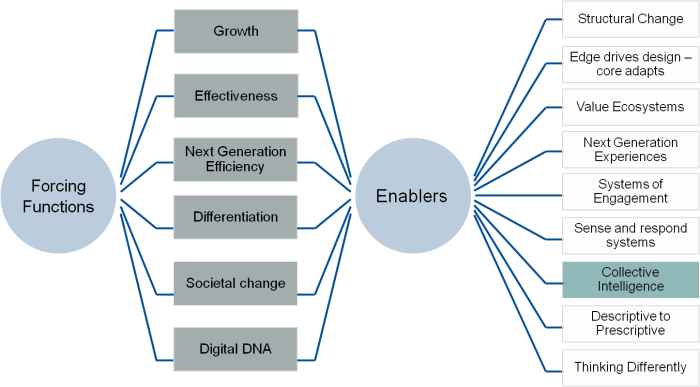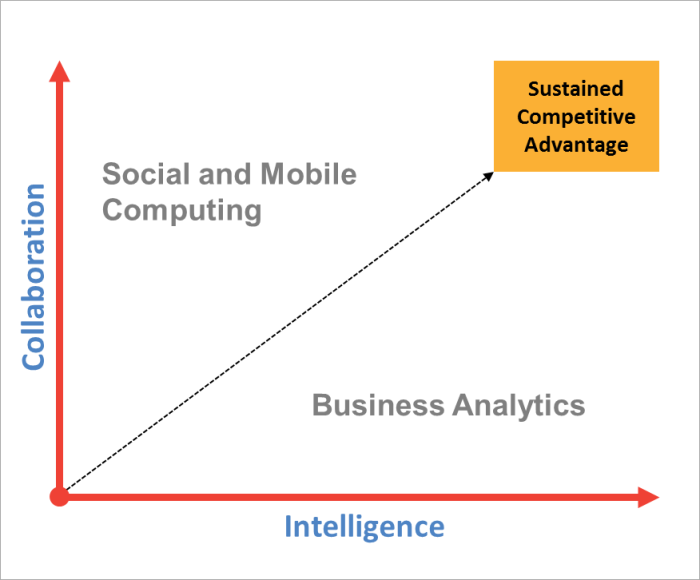Next up in this transformation series is the seventh enabler: Collective Intelligence. One of the key themes throughout this transformation series is the clear movement from an enterprise entity to an extended enterprise of stakeholders. This extended enterprise – or what I alternatively call value ecosystem – increases complexity and requires a new management approach to be effective. I use the term collective intelligence as an umbrella phrase that combines the critical need for both collaboration and analytic excellence. This includes other forces like crowd computing, crowdsourcing, co-creation, and wisdom of the crowd – all of which stem from the connectedness of our world, and the growing realization that value creation requires a broader community.
Collective intelligence allows us to harness the efforts, knowledge and brainpower of a community. It satisfies the critical need to share and use knowledge that increasingly exists across multiple stakeholders. This includes the type of knowledge you gain through personal experience. This tacit knowledge is difficult to share, as it is the unwritten, unspoken and hidden knowledge held by all of us. The capture and use of tacit knowledge through emerging systems of engagement will ultimately contribute to the effectiveness of the extended enterprise.
Thanks to advances in technology, individuals, groups and computers can collectively act more intelligently than ever before. For example, it is the sharing and connectedness enabled by social networks that allows us to better leverage tacit knowledge. As a number of forces complicate the capture and use of knowledge, companies will increasingly exploit these networks to tap into it. Once leveraged, this intelligence allows complete ecosystems to unleash the knowledge, creativity, ideas and innovation so necessary for future survival. The drivers behind the collective intelligence enabler are:
- Value ecosystems complicate collaboration and exacerbate the diffusion of knowledge – I described the drivers of value ecosystems as part of this transformation series in an earlier Post. As this movement from vertical integration to business networks continues, effective collaboration becomes critical, and the complications introduced by knowledge diffusion must be addressed
- Critical information increasingly resides with stakeholders in the ecosystem – critical business information is increasingly in the heads of our employees, partners and customers rather than within systems of record. As the number of stakeholders involved in value creation expands, so does information management complexity
- Structural change – industrial age structures are shifting in a very profound way: from a manufacturing economy focused on physical production to a service economy based on idea production, knowledge, creativity and design. Along with this shift comes the shrinking of innovation cycles in the global environment and the need for every company to accelerate and broaden the production of ideas. A recent Forrester Report determined that at least ten times more digital innovators can operate at one-tenth the cost or less, generating at least 100 times more idea power than under traditional disruption. To compete, ideas cannot be the sole realm of an organizational function, but the collective intelligence of communities. Ideation across an ecosystem will grow more important, driving investment in mechanisms that enable this ideation. In addition, every company must excel at the use of knowledge, design thinking, and creativity. Excelling in these areas requires an effective way to leverage the broader ecosystem, putting pressure on companies to leverage systems of engagement and the resulting collective intelligence
- The competitive environment is intensifying – for a number of reasons, barriers to entry are falling and the competitive environment is growing more intense. With this comes the need to create and sustain competitive advantage through innovation, execution and smarter decision making. To enable this competitive advantage, companies will seek to expand ideation to include a broader community (innovation), leverage a broader base of intelligence (smarter decision making) and deploy systems of engagement to enable effectiveness (execution)
- Talent is becoming more distributed – multiple trends like the distribution of work to crowds, the rise of perpetual freelancers, and value creating tasks performed across an extended enterprise all lead to the externalization of work. As more work is dispersed, knowledge is further distributed. This diffusion of knowledge further complicates knowledge management efforts and drives the need for capability that effectively harnesses the intelligence of a broadening ecosystem
One might say that I have believed in the collective power of communities for quite some time. I developed the extended enterprise visual below back in 2000. Since my CTO days at Fujitsu Consulting, much has changed and software and technology have evolved to where this vision is attainable.
Extended Enterprise
The same vision is portrayed in my new visual on value ecosystems, reflecting the enabling innovations of our day – developed as part of my current digital enterprise efforts at Tata Consultancy Service (TCS).
Value Ecosystems
Realizing this vision is becoming a business imperative. At a time when companies in many industries have similar offerings and use comparable technology, many of the previous bases for competition are no longer viable. In a global environment, physical location is frequently not a source of advantage, protectionist regulation is increasingly rare, and proprietary technologies are rapidly copied. The bases therefore for future competitive advantage is innovation, execution and smart decision making. This places a premium on excellence in two key areas: collaboration and the use of all available intelligence. Collaboration must expand to include the extended business community; employees, partners, customers, consumers, citizens, government, universities, and other stakeholders.
By expanding the community and effectively enabling collaboration, all three business imperatives are addressed. When the collective intelligence of a community is tapped, new forms of innovation emerge and the speed of that innovation forms the foundation for future competitive advantage. This networked enterprise will make great strides towards operational excellence (execution) and incorporates much more intelligence from an expanded base of data (smart decision making). With this as a backdrop, the tactics that should be included in collective intelligence programs are:
- Leverage the ecosystem – extend the enterprise. Co-creation, crowd computing, crowd funding, and crowdsourcing are examples of using an extended enterprise to support various business initiatives and outcomes. In the case of crowd computing for instance, leveraging a crowd as part of a virtual workforce enables expertise and specialist sourcing at the time of need. A great example is provided by Crowd Computing Systems, as they combine crowd sourcing, machine learning and artificial intelligence to perform work on a massive scale. Use current and emerging mechanisms to pull the ecosystem into value creation activities
- Evolve enterprise strategy and architecture – to enable collaboration and analytics excellence, successful enterprise strategies and architectures will move the enterprise forward on the two axes depicted in the visual below. This simple visual describes the pillars of excellence required for future success. Companies should move to create a collaborative environment enabled by social and mobile computing, and expand from traditional business intelligence to advanced analytics that deals with both structured and unstructured data. The higher up the collaborative axes you go, the more critical the need to effectively gather and leverage the resulting intelligence – and the more challenging the task becomes. As visualized in the value ecosystem diagram above, a supporting architecture that leverages systems of engagement with an advanced analytics foundation enables the enterprise to address these challenges
- Deploy systems of engagement – the networked enterprise will use mobile as the face of engagement and collaborative social technologies to extend the organization’s reach to customers, partners, and other stakeholders, while connecting the internal efforts of employees. These technologies are deployed as part of future systems of engagement and the connectedness they enable allows a company to create a knowledge ecosystem and a collective knowledge base. But an emerging danger exists, as three separate and distinct ecosystems (customer, employee and partner) are forming in many companies, undermining value realization and holding back collective intelligence initiatives. If viewed and deployed holistically, these systems create a collaborative decision making environment where collective intelligence is captured, shared and used to drive business outcomes
- Move towards a culture of openness, accountability, transparency and trust across the ecosystem – as the enterprise evolves over the coming decades, openness, transparency and trust form the foundation. This evolution enables open-minded individuals to collaborate, share, and use intelligence across organizational boundaries. The most successful organizations will have leaders that understand this commitment to cultural evolution
- Re-imagine everything – current enterprise structures (process, policy, systems, organization design, etc.) that were born in a different time do not effectively support value creation in a connected world. Most tools for modern management were invented by 1920 and have not changed since. This excellent Presentation by Gary Hamel makes a great argument for reinventing management. As with each of the other enablers, a critical step in establishing collective intelligence capability is an openness to re-imagine and challenge the status quo
- Enable the effective analysis and use of insight derived from collective intelligence – the collective intelligence of an ecosystem can only help if it is leveraged to drive business outcomes. Future sense and respond systems (see value ecosystem architecture diagram above) will leverage the intelligence flowing through these ecosystems to enable actions, drive better decisions, and ultimately optimize business outcomes. Connecting collective intelligence capability to the analytic platform is a critical enabling step
- Automate knowledge work – as more intelligence is created and knowledge flows across a broader ecosystem, the effective application of that knowledge grows more critical. Innovation is enabling the automation of knowledge work and the creation of automated closed-loop systems where knowledge is applied to deliver business outcomes. Operating within these emerging value ecosystems will require the development of these closed loop systems
That’s a look at the seventh enabler. For a review of this transformation series to date, here are the links to each of the prior posts:
Forcing Functions:
Enablers:





[…] Next up in this transformation series is the seventh enabler: Collective Intelligence. One of the key themes throughout this transformation series is the clear movement from an enterprise entity to… […]
LikeLike
[…] Next up in this transformation series is the seventh enabler: Collective Intelligence. One of the key themes throughout this transformation series is the clear movement from an enterprise entity to an extended enterprise of stakeholders. This extended enterprise – or what I alternatively call value ecosystem – increases complexity and requires a new management approach to be effective. I use the term collective intelligence as an umbrella phrase that combines the critical need for both collaboration and analytic excellence. This includes other forces like crowd computing, crowdsourcing, co-creation, and wisdom of the crowd – all of which stem from the connectedness of our world, and the growing realization that value creation requires a broader community. […]
LikeLike
[…] A Closer Look at Transformation: Collective Intelligence […]
LikeLike
[…] Collective Intelligence […]
LikeLike
[…] Collective Intelligence […]
LikeLike
[…] Collective Intelligence […]
LikeLike
[…] Collective Intelligence […]
LikeLike
[…] Next up in this transformation series is the seventh enabler: Collective Intelligence. One of the key themes throughout this transformation series is the clear movement from an enterprise entity to an extended enterprise of … […]
LikeLike
[…] Collective Intelligence […]
LikeLike